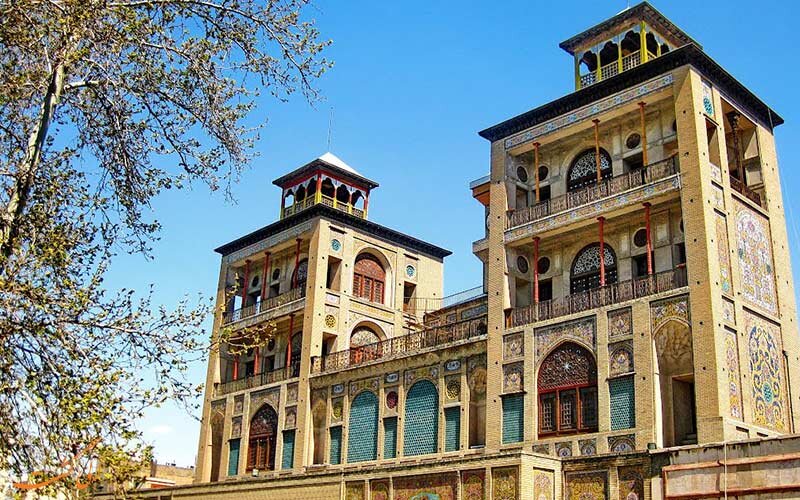A peek into some of Tehran’s most stunning buildings

TEHRAN - Embracing the lower slopes of the glorious, snowcapped Alborz Mountains, Tehran is the dynamic beating heart of the country and the best place to understand modern Iran and what its likely future holds.
You can travel through more than 250 years of Iranian history by exploring this fascinating city, from the glittering palaces and the vaulted bazaars to the lovely Azadi Tower and former U.S. embassy, to name a few.
Furthermore, you can unwind and take in all that Tehran has to offer at one of the city’s many top-notch museums, tranquil gardens, modern cafes, and traditional teahouses, or while hiking through the mountains.
Here are 10 of the most impressive structures in the Iranian capital, ranging from structures with European influences to contemporary interpretations of old-world architecture.
Green Palace
One of the buildings of the Sa’ad Abad Complex and perhaps the most beautiful is the Green Palace. It was built at the end of the Qajar era and later remodeled by Reza Shah, serving as his residence for one year, before turning into a guest house.
Brought from mines in the Zanjan and Khorasan provinces, the marble used to construct its exterior has a unique hint of green. Just as elaborately designed are the interiors, with a mirror hall and a Persian rug woven over seven years, among their other ostentatious features.
Cinema Museum
You can’t help but be mesmerized by a mansion that beckons attention as you stroll down Valiasr Street. Iran Cinema Museum is housed in a Qajar-era estate that is located behind Ferdows Garden.
The balcony is the most charming element, with its walls and columns covered in intricate floral plasterwork and arched wooden-framed windows. You can learn about Iran’s century-old film industry through the exhibitions, and the nearby coffee shops to let you take your time admiring the structure while you sip tea.
Abgineh Museum
The Glassware and Ceramic Museum of Iran, or simply Abgineh Museum, was originally a mansion built by Ahamd Qavam, the 20th-century politician who served as Prime Minister of Iran.
The mansion later served as Egypt’s embassy before becoming a museum in 1976. It skillfully combines Iranian and European architectural styles, and the staircase connecting the first and second floors is Russian.
The interior of this building is just as lovely as the exterior, if not more so, thanks to the elaborate plasterwork, carved wooden columns, and crystal chandeliers.
Golestan Palace
In 2013, UNESCO designated Golestan Palace as a World Heritage site. It is made up of a collection of royal structures that were once the Qajar era’s administrative center.
It is a prime example of the blending of Persian and Western architecture, with immaculate archways, mirrored halls and ceilings, and ornamental tiles all positioned inside the boundaries of a lavish Persian garden.
Among the many highlights are the ancient Persian badgirs (or windcatchers), along with arrays of exquisite, varied mosaics bordering the rounded windows.
Shams-ol-Emareh
Shams-ol-Emareh, or the Edifice of the Sun, is a masterpiece that deserves to be recognized on its own even though it is a part of the UNESCO-designated Golestan Palace. A tower with a 360-degree view of the city was one of Nasser al-Din Shah’s initial projects. Two years after work started, in 1867, it was completed.
The building has a central open hall and twin two-tiered towers on top with arched windows and elaborate tilework. It is simple to picture Nasser al-Din Shah achieving his desired view, even though it is not possible to climb to the top.
Te’atr-e Shahr
Constructed in the early 1970s, Te’atr-e Shahr (Theater of the City) deserves admiration for its cylinder-shaped design, which combines the conventional and contemporary.
The grand entrance has a cozy, earthy feel because it is made of wood. Moreover, its hypostyle roof adds geometric patterns that are then covered in ceramic tiles.
The monument still remains a top location for the performing arts and has multiple stages.
Saraye Roshan
On Naser Khosrow St. stands the captivating Saraye Roshan. This gothic-inspired structure, built in 1932 as one of the countries of Iran’s first commercial centers, is remarkably out of the ordinary.
While the faces and statues, which are hardly ever seen elsewhere in Iran, are more akin to European architecture, Ahura Mazda, the Zoroastrian god at its center, gives it a distinctly Persian feel.
Tehran Museum of Contemporary Art
The Tehran Museum of Contemporary Art is Iran’s largest art gallery and an impressive concrete achievement.
The four buildings perched atop the structure, which resemble a modernized version of the wind-catchers from ancient Persia, are one way in which this is particularly expressed.
Masoudieh Palace
One of the most exquisite historical structures from the Qajar era is Masoudieh Palace, which was built in 1879.
It has been the site of numerous occasions, including the founding of the first ministry of education and the opening of the first official library.
Plasterwork, mosaics, and gardens are just a few of their distinguishing features. Today, it’s a well-liked location where tourists enjoy brunch in the quaint café with stained-glass windows before exploring the area and taking pictures of the picturesque building.
Tamashagah Zaman
In addition to housing a sizable collection of timepieces and being the pinnacle of genuine Iranian architecture, Tamashagah Zaman (also known as the Time Museum) is set within a lavish Persian garden.
Many clocks and watches are on display in this historical manor house, which once belonged to renowned Iranian businessman Hossein Khoddad.
The interior never fails to astound with its ornamented ceilings, plasterwork, and vibrant stained glass windows. The pastel-blue exterior boasts windows that resemble cream-colored lace.
AFM
